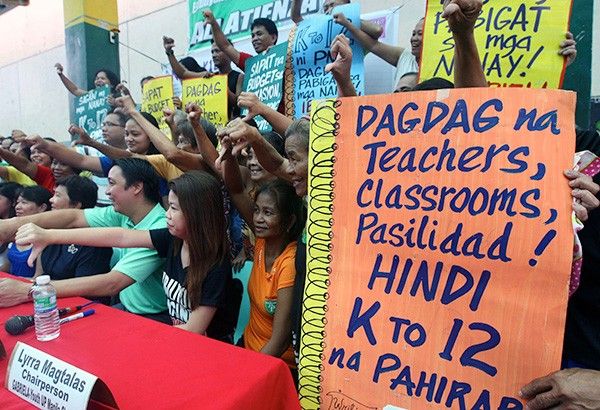COA to DOLE: Return P392 million fund for K-12

MANILA, Philippines — The Commission on Audit (COA) has directed the Department of Labor and Employment (DOLE) to remit to the Bureau of Treasury (BTr) a total of P392.107 million in unused fund intended for an assistance program for teachers and other school personnel displaced by the implementation of the K-12 education reform program.
Based on the COA’s 2017 audit report recently published on its website, Congress has allocated to DOLE a total of P500 million and P150 million in 2016 and 2017, respectively, for the implementation of its “Adjustment Measures Program (AMP) for Displaced Workers in the K-12 curriculum.”
Under the program, teachers and other personnel of higher educational institutions (HEIs) displaced through retrenchment or after availing of voluntary separation program or early retirement, among other reasons, shall receive monthly financial support from DOLE for six months in the case of permanent displacement and for three months in the case of temporary displacement.
Beneficiaries of the program will also be provided with access to available jobs suitable to their qualifications as well as to livelihood opportunities under DOLE’s Integrated Livelihood and Emergency Employment Program (DILEEP).
COA, however, noted the P150-million allocated fund for 2017 was no longer released by the Department of Budget and Management upon the request of DOLE itself since the latter still has an unused fund of P472.330 million from its 2016 allocation.
The audit body said that as of Dec. 31, 2017 or two years after the AMP’s implementation, only P80.223-million of the fund had been utilized, leaving a balance of P392.107 million.
“The huge unutilized funds of P392,107,039.32 indicate the inefficient utilization of the allotted resources,” COA said.
“We recommended that (DOLE) management revert the unused fund and henceforth, develop a program that will genuinely redound to improving the living condition of other displaced poor workers who are underemployed,” it added.
It was in school year 2016 when the Department of Education (DepEd) started the implementation of the Kindergarten plus 12 years of basic education or K-12, following the enactment of Republic Act 10533 or the Enhanced Basic Education Act of 2013.
The K-12 system added two more years in the high school curriculum, triggering concerns many personnel of colleges and universities would lose their jobs.
The COA, however, said the funds allocated for the DOLE’s adjustment program were “excessive” as proven by the low turnout of HEI personnel who availed of the assistance.
“Evaluation of the Budget and Accomplishment Report (BAR) revealed that there were no specific planned target beneficiaries for the implementation of the K to 12 DOLE AMP,” COA said.
The agency also noted that while the Philippine Institute for Development Studies (PIDS) had projected that 14,243 HEI personnel would be displaced from 2016 to 2017 due to the country’s transition to K-12 system, only 4.25 percent or 606 HEI personnel availed of the DOLE’s AMP, showing that the K to 12’s implementation “had no adverse economic impact” on the HEIs.
COA also said various partner agencies have already provided interventions to the displaced HEI personnel, which also contributed to the low utilization of the DOLE’s AMP fund.
COA said there were 1,473 reported displaced HEI personnel who did not avail of the DOLE’s AMP “despite the increased amount of financial assistance and intensified information dissemination activities.”
“We pointed out that the teaching profession does not belong to the vulnerable sector of the work force that is easily displaced considering the growing demand for private tutors and the retention capacity of the HEI’s for its compliance to the required student-teacher ratio,” COA maintained.
In a reply incorporated in the audit report, the DOLE acknowledged COA’s observations and promised to revert the unused fund to the National Treasury.
DOLE also informed the audit body that it had developed a “Job Displacement Monitoring System as a platform to validate the displacements and to avoid duplication of availment of services in close coordination with CHED, DepEd and TESDA.”
- Latest
- Trending































